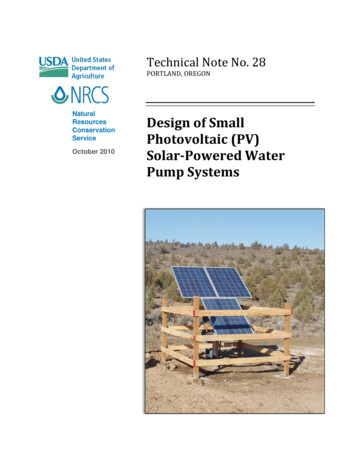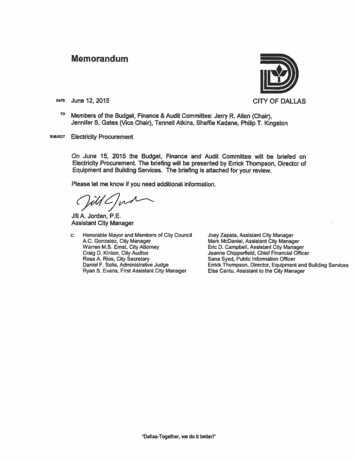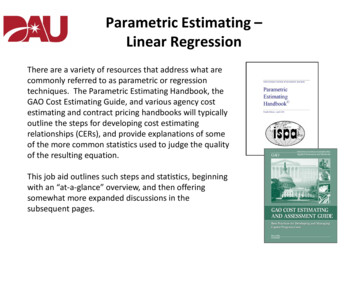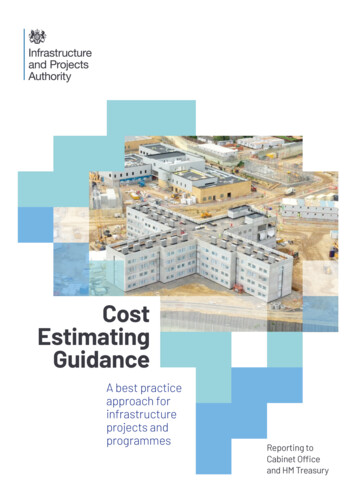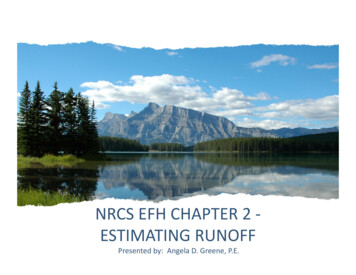
Transcription
NRCS EFH CHAPTER 2 ESTIMATING RUNOFFPresented by: Angela D. Greene, P.E.
Definitions Surface runoff – the volume ofexcess water that runs off adrainage area. Peak discharge is the peak rate ofrunoff from a drainage area for agiven rainfall. EFH-2 Assumption: Rainfall is theprimary source of water that runsoff the surface of small ruralwatersheds.
General The main factors affecting thevolume of rainfall that runs off thesurface are the kind of soil and thetype of vegetation in thewatershed. Factors affecting the rate at whichwater runs off are the watershedtopography and shape along withconservation practices on awatershed.
Rainfall The peak discharge from a small ruralwatershed is usually caused byintense rainfall. To avoid the use of a different set ofrainfall intensities for each drainagearea, a set of synthetic rainfalldistributions was developed. This set maximizes the rainfallintensities by including short durationwith those needed for longerduration.
Rainfall (Continued) Based on the watershed size for whichNRCS typically provides assistance, astorm duration of 24 hours was chosenfor the synthetic distribution. The 24-hour storm while longer thanneeded to determine peak discharges, issuitable for determining runoff volumes. A single storm duration and theassociated synthetic rainfall distributioncan be used to estimate peak dischargesfor a wide range of watershed areas.
Rainfall (Continued) The intensity of rainfall varies significantlyduring the storm period. Four 24-hour storm distributions weredeveloped by SCS (NRCS) from U.S. NationalWeather Service data as typical designstorms. The distributions are associatedwith climatic regions.–––––Type IType IAType II (All of NC except Coastal Plain)Type DMV-Delmarva (Coastal Plain of NC)Type III
Hydrologic Soil Groups NRCS Soil Scientists have classified soils into fourhydrologic soil groups– Group A – Low runoff potential and high infiltrationrates even when thoroughly wetted. Mostly sands andgravels that are deep, well drained to excessivelydrained with a high rate of water transmission ( 0.30in/hr).– Group B – Moderate infiltration rates when thoroughlywetted. Mostly moderately deep to deep soils that aremoderately well drained to well drained withmoderately fine to moderately coarse textures.Moderate rate of water transmission (0.15 to 0.30 in/hr)
Hydrologic Soil Groups (Continued)– Group C – Low infiltration rates when thoroughlywetted. Chiefly consists of soils with a layer thatimpedes downward movement of water withmoderately fine to fine texture. Slow rate of watertransmission (0.05 to 0.15 in/hr).– Group D – High runoff potential with very lowinfiltration rates when thoroughly wetted. Mostly claysoils with high swell potential, soils with a permanenthigh water table, soils with a claypan or clay layer at ornear the surface, and shallow soils over nearlyimpervious material. Very low rate of watertransmission (0 to 0.05 in/hr).
Factors Affecting Runoff Cover type Conservation practices or treatment– Reduce erosion– Maintain an open structure at the soil surfacewhich reduces runoff. The effect diminishesquickly with increases in storm magnitude. Hydrologic conditions– Affects the volume of runoff more than anyother single factor– Consider the effects of cover type andtreatment on infiltration and runoff– Generally estimated from density of plantcover and residue on the ground surface
Topography Slopes in a watershed have a majoreffect on the peak discharge atdownstream points. As watershed slope increases, velocityincreases, Tc decreases, and peakdischarge increases. An average watershed is fan shaped. Ifthe shape is elongated or morerectangular, the Tc increases and peakdischarge decreases.
Potholes and Marshland Potholes may trap rain and as a result reducethe amount of runoff. If potholes and marshland areas make up 1/3or less of the total watershed and do notintercept the drainage from the remaining2/3, they will not contribute much to thepeak discharge.– These areas may be excluded from thedrainage area for estimating peak discharge.– If potholes or marshland constitute more than1/3 of the total drainage or they intercept thedrainage, use NEH-4 procedures to estimatepeak discharge.
Limitations of EFH-2 Procedures The watershed drainage area must be greaterthan 1.0 acre and less than 2,000 acres. NOTE: If the drainage area is outside theselimits, another procedure such as TR-55 or TR20, Project Formulation - Hydrology, should beused to estimate peak discharge. The watershed should have only one mainstream. If more than one exists, the branchesmust have nearly equal Tc’s.
Limitations of EFH-2 Procedures (Continued) The watershed must be hydrologically similar[i.e., able to be represented by a weightedcurve number (CN)]. Land use, soils, and coverare distributed uniformly throughout thewatershed. The land use must be primarilyrural. If urban conditions are present and notuniformly distributed throughout thewatershed, or if they represent more than 10percent of the watershed, then TR-55 or otherprocedures must be used.
Limitations of EFH-2 Procedures (Continued) If the computed Tc is 0.1 hour, use 0.1 hour. If thecomputed Tc is 10 hours, peak discharge shouldbe estimated using the NEH-4 procedures whichare automated in the TR-20 computer program. When the flow length is 200 feet or 26,000feet, use another procedure such as TR-55 toestimate Tc and peak discharge. Runoff and peak discharge from snowmelt or rainon frozen ground cannot be estimated using theseprocedures. NEH-4 (TR-20) provides a procedurefor estimating peak discharge in these conditions.
Limitations of EFH-2 Procedures (Continued) If potholes constitute more than one-third ofthe total drainage area or if they intercept thedrainage, use the procedures in NEH-4. When the average watershed slope is 0.5percent, a different unit hydrograph shape can beused. Contact the State Conservation Engineer fornecessary information. When the weighted CN is 40 or 98, use anotherprocedure to estimate peak discharge.
Limitations of EFH-2 Procedures (Continued) When the average watershed slope is 64 percentor 0.5 percent, used another procedure such asTR-55 to estimate Tc. Accuracy of peak discharge estimated by thismethod will be reduced if Ia/P ratio used is outsidethe range given in Exhibits 2-I, 2-II, and 2-III.– The limiting Ia/P ratios are to be used. For example:if Ia/P in Exhibit 2-II is 0.1, use 0.1; and if Ia/P is 0.5, use 0.5.
Estimating Runoff The runoff from a watershed may beexpressed as the average depth ofwater that would cover the entirewatershed. The depth is usuallyexpressed in inches. The volume of runoff is computed byconverting depth over the drainagearea of the watershed to volume. Thevolume is usually expressed in acrefeet.
Runoff Curve Number (CN) The SCS runoff equation is:(P-Ia)2Q (P-Ia) SWhere Q runoff (inches)P rainfall (inches)Ia initial abstraction (inches)S potential maximum retentionafter runoff begins (inches)
Initial Abstraction (Ia) Includes all losses before runoffbegins.––––Water retained in surface depressionsWater intercepted by vegetationWater lost to evaporationInfiltration Through studies of many smallagricultural watersheds, Ia was foundto be approximated by:Ia 0.2S
Runoff Curve Number (CN) Substituting Ia 0.2S in the SCS runoffequation:Q (P-0.2S)2P 0.8S Since potential maximum retentioncan range from 0 on a smoothimpervious surface to infinity in deepgravel, the S-values were converted toCN’s:CN 100010 S
Runoff Curve Number (CN) Using the previous equation,when S is zero, the CN is 100. As S approaches infinity, the CNapproaches zero. Therefore, CN’s can range fromzero to 100 But for practical applications,CN values are limited to a rangeof 40 to 98
Estimating Runoff (Q) When CN and rainfall (P) have beendetermined for the watershed,determine runoff (Q) by using Figure 226 (Page 2-40) or Table 2-2 (Page 2-84). COMPLETE EXERCISE BY HAND– Determine CN (runoff curve number)using Worksheet 1 (Page 2-90)– Determine P (rainfall)– Determine Q (runoff)
Time of Concentration (Tc) Tc is the time it takes for runoff totravel from the hydraulically mostdistant point of the watershed tothe outlet. Tc influences the peak discharge.– For the same size watershed, theshorter the Tc, the larger the peakdischarge.
Time of Concentration (Tc) Tc can be estimated for small ruralwatersheds using the followingempirical relationship: Tc l0.8[(1000/CN) – 9]0.71140 Y0.5Where:Tc time of concentration (hours)l flow length (feet)CN runoff curve numberY average watershed slope in percent
Average Watershed Slope (Y) The average watershed slope (Y) is theslope of the land and not the watercourse.– Average watershed slope is an average ofindividual land slope measurements. Y can be determined using the followingrelationship:Y 100CIAWhere Y Avg WS Slope (percent)C total contour length (feet)I contour interval (feet)A drainage area in square feet
Flow Length (l)Flow length is the longest flow path in thewatershed from the watershed divide tothe outlet. It is the total path water travelsoverland and in small channels on the wayto the outlet. Use topo map to determine l and Y. Use the nomograph in Figure 2-27 (Page2-41) to determine Tc by completing thetop part of Worksheet 2 on Page 2-91.
EXERCISE:Estimating Peak Discharge (qp) Use Q, Ia/P, Tc and the nomograph on Page2-14 to estimate Unit Peak Discharge (qu)for 1-YR, 2-YR, & 25-YR 24-HR stormsusing the Type II storm distribution. Calculate Peak Dischargeqp qu x DA x QWhere:qu unit peak discharge (cfs/ac/in)DA drainage area (acres)Q runoff (inch)
Complete Worksheet 2Congratulations! Time to check your work.Check your hand calculations by enteringthe data in the EFH-2 Software Program
for the synthetic distribution. The 24-hour storm while longer than needed to determine peak discharges, is suitable for determining runoff volumes. A single storm duration and the associated synthetic rainfall distribution can be used to estimate peak discharges for a wide range of watershed areas.





